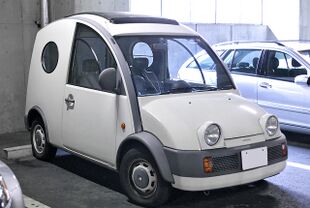Engineering:Nissan S-Cargo
| Nissan S-Cargo | |
|---|---|
 A white Nissan S-Cargo, with canvas roof and quarter window | |
| Overview | |
| Manufacturer | Nissan |
| Production | 1989–1991 8,000 produced |
| Body and chassis | |
| Class | Light commercial vehicle |
| Body style | 2-/3-door van |
| Layout | FF layout |
| Powertrain | |
| Engine | 1.5L E15 I4 |
| Transmission | 3-speed automatic |
| Dimensions | |
| Wheelbase | 89 in (2,261 mm) |
| Length | 137 in (3,480 mm) |
| Width | 62.8 in (1,595 mm) |
| Height | 72.4 in (1,839 mm) |
| |uk|Kerb|Curb}} weight | 2,097–2,141 lb (951–971 kg) |
The Nissan S-Cargo is a small retro-styled van manufactured by the Japanese automaker Nissan from 1989 to 1991, and originally marketed solely in Japan at their Nissan Cherry Stores.
The exterior styling of the S-Cargo was inspired by the Citroën 2CV Fourgonnette delivery van, and interior styling borrowed a Citroën-style single-spoke steering wheel. The name was a double entendre, standing for "Small Cargo" and sounding like "escargot", the French word for snail, which in turn is a nickname for the Citroën 2CV.
The S-Cargo was introduced at the Tokyo Motor Show in 1989,[1] was originally marketed without Nissan branding and was available by reservation only. Over its two-year production run, 8,000 were produced[1] (variously reported as 12,000).
Because of its origins at Pike Factory, (Nissan's special project group), the S-Cargo—along with the Nissan Figaro, Be-1 and Pao—are known as Nissan's "Pike cars."

In 2011, noted design critic Phil Patton, writing for The New York Times , called the Pike cars "the height of postmodernism"[2] and "unabashedly retro, promiscuously combining elements of the Citroën 2CV, Renault 4, Mini [and] Fiat 500."[2]
Specification
The S-Cargo was equipped with a 1.5 L E15S 4-cylinder petrol/gasoline engine, a 3-speed automatic transmission, and air conditioning. It was based on the B11 Station Nissan Sunny.[citation needed]
Optional items included:
- An oval-shaped portal window installed on each side panel of the van.
- An electric canvas sunroof.
References
- ↑ 1.0 1.1 "S-Cargo (1989 : G20) Commercial Vehicle". Nissan Global. http://www.nissan-global.com/EN/HERITAGE/s_cargo_230.html.
- ↑ 2.0 2.1 Patton, Phil (March 18, 2011). "Nissan's Cartoon Cars, Once So Hip". The New York Times. https://www.nytimes.com/2011/03/20/automobiles/20PIKE.html.
External links
- Import Driver Review (archived link)
- DeMuro, Doug (October 2016). "I Purchased the Ugliest Car Ever Made". AutoTrader.com. http://www.autotrader.com/car-video/i-purchased-the-ugliest-car-ever-made-257827.
 |

